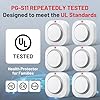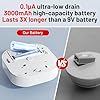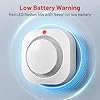If you have a home with multiple levels, you may be wondering if your smoke detectors are interlinked. In this blog post, we’ll show you how to tell if your smoke detectors are interlinked and what to do if they’re not.
Contents
How do I know if my smoke detectors are interlinked?
Most smoke detectors available on the market today are interlinked, meaning that if one smoke detector sounds an alarm, they all will. This is a feature that is especially important in a home with multiple levels, as it ensures that everyone in the home will be alerted to a fire, no matter where it is. There are a few ways to tell if your smoke detectors are interlinked.
First, most interlinked smoke detectors will be labeled as such on the packaging. If you are unsure, you can always contact the manufacturer of your smoke detectors to ask. Second, when you test your smoke detectors, usually by pressing the test button, all of the interconnected detectors should sound an alarm. If only some of them sound, or if they do not sound at all, they are likely not interconnected.
Lastly, most interlinked smoke detectors will be hardwired into your home’s electrical system. This means that they will have a power cord that plugs into an outlet, rather than running on batteries. If your smoke detectors are not hardwired, they are likely not interconnected.
Interlinked smoke detectors are an important safety feature in any home. If you are unsure if your smoke detectors are interconnected, it is best to contact the manufacturer or an electrician to help you determine.
How to properly test your smoke detectors?
When it comes to testing your smoke detectors, you want to make sure that they are all interconnected. This way, if one smoke detector goes off, they all will. This is important because it ensures that everyone in the home is alerted to the fire, no matter where they are.
The best way to test your smoke detectors is to use a smoke detector tester. You can purchase these online or at your local hardware store. Smoke detector testers are designed to simulate the smoke that is produced by a fire.
To use the tester, simply hold it up to the smoke detector and press the button. The tester will then emit a small amount of smoke. If the smoke detector is working properly, it will sound the alarm.
You should test your smoke detectors once a month to ensure that they are working properly. If you have any concerns about your smoke detectors, or if they are not working properly, you should contact a professional.
Why interlinked smoke detectors are important?
While interconnected smoke detectors are not required by law, they are strongly recommended by fire safety experts. Here’s why:
In the event of a fire, every second counts. You may have only a minute or two to escape. Smoke detectors that are not interconnected can delay the notification of a fire, giving the fire more time to spread.
With interconnected smoke detectors, when one smoke detector sounds, they all sound. This gives you an early warning of a fire, so you can take action quickly.
Interconnected smoke detectors are also more likely to wake people up if there is a fire in the middle of the night.
Finally, interconnected smoke detectors provide a measure of redundancy. If one smoke detector is disabled, the others can still provide an early warning of a fire.
So how do you know if your smoke detectors are interconnected? If all the smoke detectors in your home sound when one is triggered, then they are interconnected. You can also check the manufacturer’s instructions to see if your smoke detectors are interconnected.
How often should you test your smoke detectors?
Smoke detectors are an important part of any home safety plan, but it’s not enough to just have them installed. You also need to make sure they are working properly. The best way to do this is to test them regularly.
How often you need to test your smoke detectors depends on the type of detector you have. For battery-powered detectors, you should test them at least once a month. For hard-wired detectors, you should test them at least once a year.
If your detectors are interconnected, then you only need to test one of them to know that they are all working. If your detectors are not interconnected, then you will need to test each one individually.
When testing your detectors, make sure to follow the manufacturer’s instructions. This will ensure that you are testing them correctly and not damaging them.
What to do if your smoke detector goes off
If your smoke detector goes off, it is important to determine whether the alarm is sounding due to an actual fire, or if it is a false alarm. If you have interlinked smoke detectors, all of the alarms will sound when one detects smoke.
This is a feature that is designed to provide early warning of a fire. If you have a single smoke detector, you will need to determine the cause of the alarm. If you cannot determine the cause, it is best to err on the side of caution and evacuate the premises.
How to change the batteries in your smoke detector?
If you live in a home with multiple levels, it’s important to have interconnected smoke detectors. That way, if a fire starts on one level of your home, the detectors on all other levels will sound. This gives you and your family the best chance to get to safety.
But how do you know if your detectors are interconnected? And how do you change the batteries in them if they are?
Here’s a quick guide to help you out.
How to tell if your smoke detectors are interconnected
There are a few ways you can tell if your detectors are interconnected:
- Check the manufacturer’s instructions. When you first bought your detectors, the manufacturer’s instructions should have told you whether or not the detectors were interconnected.
- Look for a “chirp.” Most smoke detectors will make a chirping noise when the battery is running low. If you hear a chirp coming from one detector, it’s a good indication that all of the detectors are interconnected.
- Test the detectors. The best way to know for sure if your detectors are interconnected is to test them. You can do this by lighting a candle and holding it near one detector. If all of the detectors sound, you know they’re interconnected.
How to change the batteries in interconnected smoke detectors
If you have interconnected smoke detectors, it’s important to change the batteries in all of them at the same time. That way, you can be sure that all of the detectors are working properly.
Here’s how to change the batteries in your interconnected smoke detectors:
- Start by turning off the power to the detectors. This will prevent them from sounding while you’re changing the batteries.
- Next, remove the old batteries from the detectors.
- Install the new batteries, making sure they’re installed in the correct direction.
- Finally, turn the power back on to the detectors.
- Test the detectors to make sure they’re working properly.
Now you know how to tell if your smoke detectors are interconnected and how to change the batteries in them. By following these steps, you can be sure that your detectors are working properly and that you and your family are safe in the event of a fire.
How to properly maintain your smoke detectors?
If you have a wired smoke detector system, the best way to tell if they are interconnected is to test them all at the same time. You can do this by pressing the test button on one smoke detector. If the other detectors in the system sound an alarm, then you know they are interconnected.
Wireless smoke detector systems will usually have a warning light that flashes when the batteries need to be changed. If you see this light, it means that the detectors are still interconnected and working properly.
It’s important to test your smoke detectors regularly to make sure they are working properly. You should also vacuum them regularly to remove any dust or cobwebs that might have accumulated on them.
Summary
If you have more than one smoke detector in your home, it’s important to know if they’re interconnected. That way, if one detector goes off, they all will. There are a few ways to tell if your detectors are interconnected.
First, check the manufacturer’s instructions. Many brands of smoke detectors have the interconnect feature built-in, but it’s not always activated. If you see mention of an interconnective system, that’s a good sign.
Next, take a look at the detectors themselves. If they have a wire running between them, that’s another indication that they’re interconnected.
Finally, test the detectors to see if they’re all triggered when one goes off. If they are, then you know you have an interconnected system.
Knowing if your smoke detectors are interconnected is important for your safety. If you’re not sure, take a few minutes to check and make sure.



















